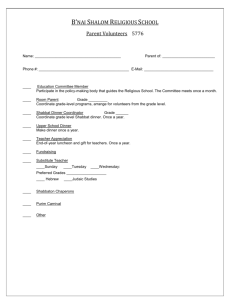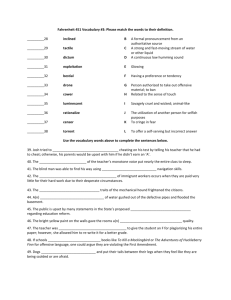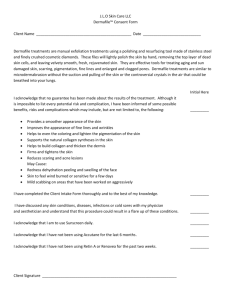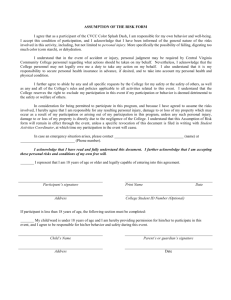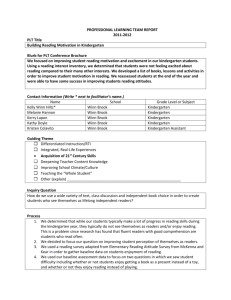Positive Communication Strategies - Suffolk Cognitive
advertisement
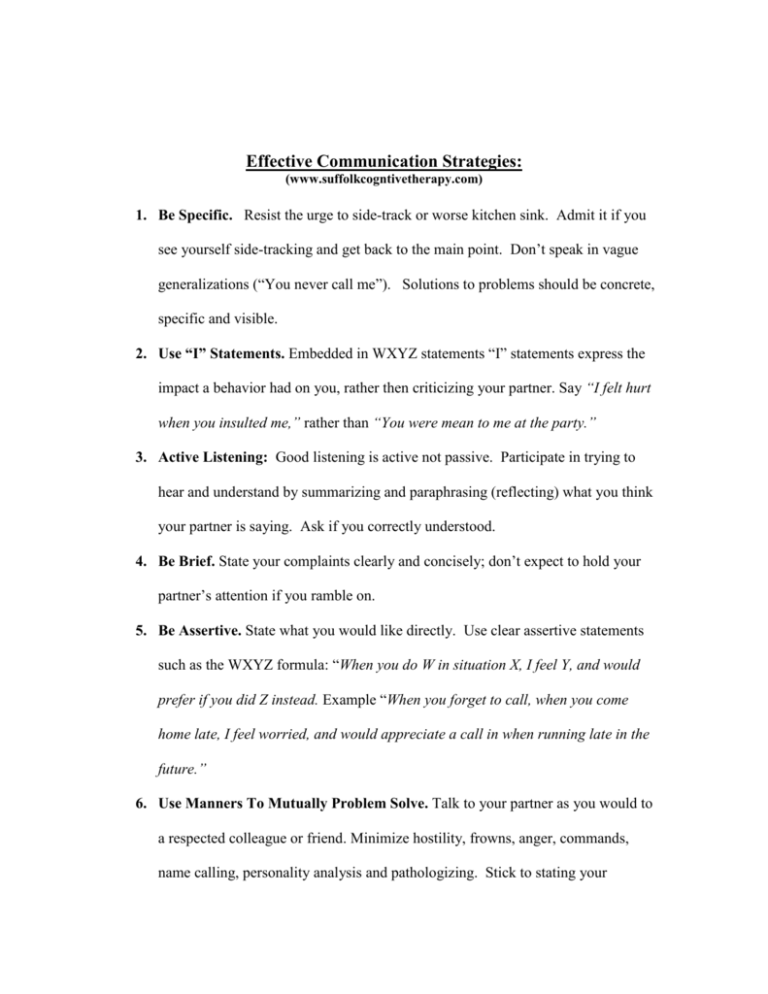
Effective Communication Strategies: (www.suffolkcogntivetherapy.com) 1. Be Specific. Resist the urge to side-track or worse kitchen sink. Admit it if you see yourself side-tracking and get back to the main point. Don’t speak in vague generalizations (“You never call me”). Solutions to problems should be concrete, specific and visible. 2. Use “I” Statements. Embedded in WXYZ statements “I” statements express the impact a behavior had on you, rather then criticizing your partner. Say “I felt hurt when you insulted me,” rather than “You were mean to me at the party.” 3. Active Listening: Good listening is active not passive. Participate in trying to hear and understand by summarizing and paraphrasing (reflecting) what you think your partner is saying. Ask if you correctly understood. 4. Be Brief. State your complaints clearly and concisely; don’t expect to hold your partner’s attention if you ramble on. 5. Be Assertive. State what you would like directly. Use clear assertive statements such as the WXYZ formula: “When you do W in situation X, I feel Y, and would prefer if you did Z instead. Example “When you forget to call, when you come home late, I feel worried, and would appreciate a call in when running late in the future.” 6. Use Manners To Mutually Problem Solve. Talk to your partner as you would to a respected colleague or friend. Minimize hostility, frowns, anger, commands, name calling, personality analysis and pathologizing. Stick to stating your feelings and requests simply and politely. Identify specific problems and generate solutions together. 7. Frame Preferences Positively (what you want them to do vs. what you want them not to do). Frame requests positively, stating what you would like more of, not only what your partner is doing wrong. Say “I would really like it if we could spend more time together in the evenings,” rather then “If you cared about me, you wouldn’t work late all the time.” Be concrete; ask for things that are visible, even measurable. 8. Make Requests, Not Demands. Ask your partner for what you would like; do not act like you are his/her boss or parent. Say “Could you please clear off the table before dinner?” Rather then “Clean the table NOW!!! 9. Give Compliments Also (Strokes), Not Just Complaints (Track Positives). Acknowledge the positive things your partner does Even a complaint can be turned into a compliment and a request: instead of “You don’t make a vegetable often enough with dinner,” say “ That salad you made last night was delicious. Why don’t we include vegetables with dinner more often”? Acknowledge efforts made by your partner. Express appreciation and demonstrate affection when things are going in the right direction. 10. Repairs: Use Smiles, Touch, Apologies, Humor. Smiling, touching and joking with your partner can cut tension and rekindle positive feelings during or after a heated exchange. Just be certain the use of humor is appropriate (e.g., laughing at your partner’s expense will not be helpful). 11. Say What You Are Willing To Do To Help. Offer help, rather then expecting your partner to make the only changes. “We should eat more fresh vegetables. I can begin to stop at the market on the way home from work a couple of times a week.” Ask what you can do to help with a specific problem. 12. Take Some Portion of Responsibility for Problems; Rather than BLAMING, acknowledge your own role in contributing to the problem: “ I know I’m not always understanding about your job; would it help you feel comfortable sharing more about it if I made more supportive comments and were less critical” 13. Edit Out Unnecessary Negative Content. Eliminate unnecessary and unhelpful content from you messages (e.g., “I’m upset because you were late for the millionth time; what the hell happened?” becomes “I’m upset because you were late, what happened?”) 14. Metacommunicate. When feeling stuck or noticing an escalation, communicate about your communication with your partner. This repair strategy helps to catch destructive processes as they are happening and demonstrates concern for the discussion outcome. Examples: “were getting off track,” “I can see we’re both starting to get upset,” or “I’m trying to understand but this is difficult. 15. Time-Outs: Agree that either of you can call a time-out if things are getting too heated. Both of you must respect the others time out request.


